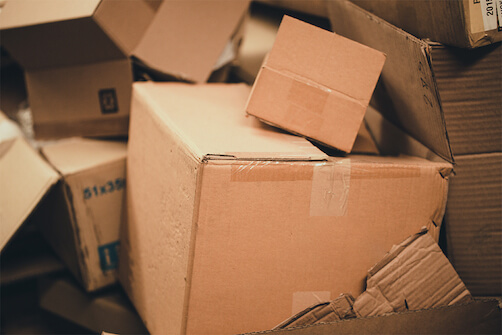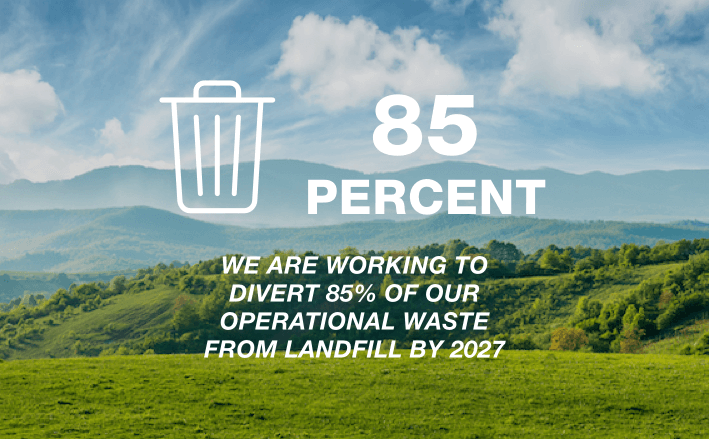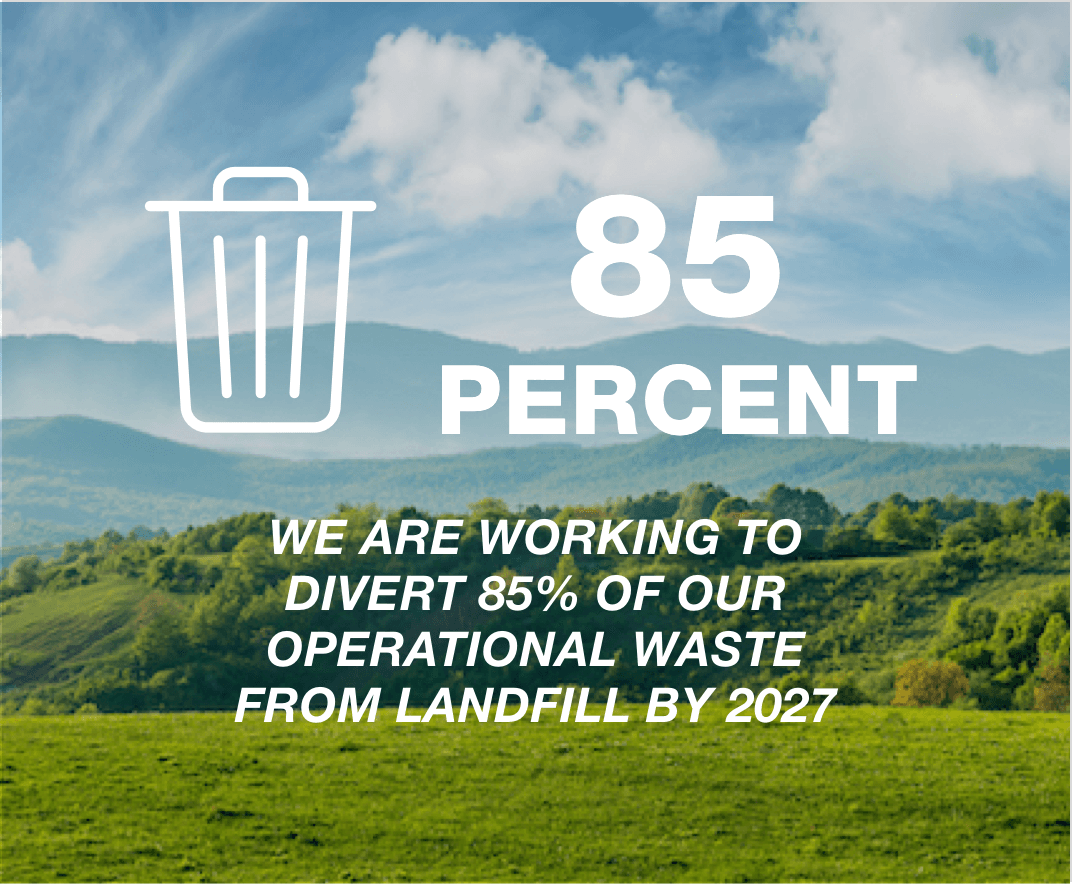Teams throughout our business work to implement cost-effective strategies and
processes to manage
the many different types of waste materials resulting from our operations. We are doing this in
several ways,
including by eliminating operational waste where feasible and by maximizing the reuse and recycling
of materials in
our stores, distribution centers, and corporate offices. These efforts support our global goal of
working to divert
85% of operational waste from landfill by 2027.
Our global approach to managing operational waste includes efforts to:
Maximize reuse and recycling of operational waste, of which the majority is corrugate boxes
Collaborate with our waste-haulers and certain vendors and suppliers on solutions that improve
our ability to
divert operational waste materials from landfill
Update and enhance our communications on sortation and recycling procedures within certain
stores
Address single-use plastics in our operations
Explore opportunities for certain geographies to expand merchandise recovery and reuse programs
FY23 Waste Metrics
Global Operational Waste Diversion Rate:1
Regional Diversion Rates:
GHG Emissions from Waste Generated in Operations (Scope 3, Category 5):
34,700 metric tons of CO2e - a 26% year-over-year reduction compared with Fiscal 2022.
Maximizing Reuse and Recycling in Our Operations
We have many programs across our global business that support our efforts to reuse and recycle our
operational waste
in our stores, distribution centers, and home offices. Recycling programs for common items, like
cardboard,
plastic, paper, aluminum, and glass have been introduced across all geographies, and we are working
to find new
ways to reduce and recycle difficult-to-recycle items, like polystyrene.
One of our efforts in this area involves backhauling materials from our stores to dedicated facilities
to be recycled
or reused. In the U.S. and Europe, we have a number of Asset Recovery Recycling Centers
(ARRCs),
which are strategically located within our service centers and have historically served as a central
destination
for regional recyclable or reusable store material. The majority of our stores in the U.S. and
Europe send used
corrugated cardboard, plastic film, excess hangers, store fixtures, display cases, and other
supplies to their
local ARRC (or in some cases in Europe, back to a processing center), where the items are processed
and can be
reused in other stores or recycled. In Fiscal 2023, we implemented new infrastructure to support our
waste goals,
including incremental resources to increase the reuse and recycling of corrugated cardboard in the
U.S. These
efforts, along with many others, contribute to our intention to make year-over-year progress against
our global
operational waste diversion target.
Over the years, the flexibility of the ARRC program has enabled us to test new initiatives as we
strive to increase
the types of materials that can be included in our recycling stream. For example, as our global
waste stakeholders
have identified polystyrene (Styrofoam) as a key area of focus, we have leveraged the ARRC to pilot
strategies to
improve our management and recycling of polystyrene packaging material.
Our efforts to improve reuse and recycling within our organization through our ARRCs in the U.S. have
returned more
than 476,000 metric tons of waste from our stores for reuse and recycling since Fiscal 2017. In
Fiscal 2024, we
plan to continue to accelerate initiatives to increase recycling rates at ARRC-serviced stores
through training and
continued education on proper sortation techniques.
Operational Highlights Across Our Geographies:
In the U.S., T.J. Maxx, Marshalls, and HomeGoods continued programs to reuse
cardboard boxes
throughout the network, and over 19.1 million reusable units of packaging were sent back from
our stores
through our network of ARRCs to be returned to distribution centers for reuse.
Our distribution centers in Canada achieved a 92% diversion rate.
In our European processing centers, we divert approximately 99% of waste from
landfills.
Decreasing Single-Use Plastics
We have regional efforts in place to identify opportunities to remove single-use plastics from our
operations and are
working with our suppliers to reduce single-use packaging.
Reducing Plastic In Our Operations
In our U.S. and Canadian Distribution Centers, we are working to find ways to
replace plastic
films that traditionally protect merchandise as it is shipped to our stores. For many years in
the U.S., we
have utilized a more easily recycled material and corrugated box insert for the packaging of
liquid products
during shipping from distribution centers to stores. This effort has resulted in an estimated
12 million fewer
plastic bags being used across our distribution network each year. In Canada, we have begun
rolling out an effort to remove the bubble wrap pouches ordinarily used to protect the
merchandise being
delivered to stores. In addition to being recyclable, we have found that the fiber-based
material being used
in its place has reduced merchandise damage and can be reused by stores to protect merchandise
carried home by
customers.
TJX Canada launched a pilot program at the end of Fiscal 2023 to work directly
with certain
vendors to reduce the amount of polystyrene shipped with merchandise by utilizing alternative
packing
material. The first shipment of merchandise using the alternative packing material arrived at
our distribution
centers and stores in early 2023. We are currently monitoring the efficacy of the new packaging
type to ensure
that it meets our business requirements.
TJX Canada has switched to a reusable system for the containers served in our
Home Office
cafeteria, helping to divert an estimated 35,000 single-use containers from
the waste stream
annually.
In Europe, we are working to reduce single-use plastics in our offices,
processing centers,
stores, and e-commerce operations. To date, we have swapped plastic tape for paper tape in our
e-commerce home
deliveries, switched to plastic-free soap sachets and cleaning products in the restrooms and
cleaning
operations of some stores and our home office, and removed single-use plastic refrigerated
beverage bottles
from our European stores.
We’re also working to address single-use plastic merchandise carry out bags. For example:
TJX is a member of Closed Loop Partners’ Consortium to Reinvent the Retail Bag, a
multi-year
collaboration across retail sectors that aims to identify, test, and scale innovative design
solutions to
serve the function of the current retail bag. As the Consortium’s Apparel and Home Goods
Sector Lead
Partner, TJX participated in the Bring Your Own Bag pilot initiative in 2023 to help encourage
customers to
bring their own shopping bags.
In Canada, regulations now prohibit the use of single-use plastic checkout bags in retail
operations nationally
and our Canadian operations teams worked to ensure that customers have options to choose
alternatives in our
stores.
In Europe, all single-use plastic merchandise carry out bags were removed from stores
in Fiscal 2021.
Customers can bring their own bags or purchase from our range of reusable bags containing recycled plastic content,
including our “bags for life,” from which a portion of the proceeds goes to one of our charity partners.
Merchandise and Packaging Programs
We have programs in place in certain regions to help support recycling and reuse of merchandise and
certain
merchandise packaging.
For example, in the U.K. and Ireland, our long-running Give Up Clothes For Good
campaign invites
customers and Associates to donate their pre-loved quality fashion and homeware at their local T.K.
Maxx. The
pre-loved items are donated to Cancer Research U.K. and Enable Ireland where they are managed for
potential reuse.
In addition to the donated goods, T.K. Maxx contributes unsold goods. As of Fiscal 2023, the
campaign has donated
more than 2 million bags of goods, helping to raise millions of pounds for Cancer Research U.K. for
Children and
Young People and Enable Ireland. Learn more
about our
efforts in our Communities section.
Additionally, in Canada, we partner with Brands for Canada at our distribution
centers and Habitat
for Humanity at our stores to donate unsold products to people in need. In Fiscal 2023, TJX Canada
also partnered
with Pact to pilot a beauty product packaging collection program at select Winners stores. The Pact
program enables
customers to drop off used beauty packaging in-store, which is then sent to Pact where it will be
sorted for
processing. We expect to begin expanding the program to all Winners stores across Canada in Fiscal
2024.
Reducing Water Consumption
Although our business operations are not water intensive, we believe reducing water usage is
consistent with both our
commitment to environmental sustainability and our low-cost operating philosophy. To that end, we
work to monitor
our water usage and identify opportunities to improve water efficiency where feasible across our
operations. For
instance, our Energy Management groups in the U.S. and U.K. monitor water usage across our home
office buildings to
identify opportunities to conserve water including time-sensor technologies to control faucets in
many of our
restrooms.
Additionally, our TJX
Vendor
Code of Conduct strongly encourages our merchandise vendors to conserve and protect
resources, such as
water and energy, and also take into consideration environmental issues that may impact their local
communities.
Environmental concerns are incorporated into our merchandise vendor social compliance training
materials as well,
introducing high-level concepts of environmental sustainability, like water conservation. Our
training includes
specific cost-saving, water-conservation recommendations for our suppliers that they may consider
implementing at
their production facilities. We plan to continue including similar relevant water facts during
future training
sessions.







